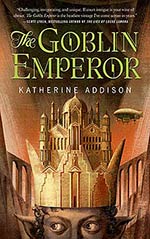
![]() noclichehere
noclichehere
10/3/2014
![]()
Sarah Monette, also known by her pseudonym as Kathrine Addison, weaves an impressive tapestry about a young man ascending from rags to riches in her novel The Goblin Emperor. The story is told through the eyes of Maia, the emperor's fourth and least favorite half-goblin son. Since his birth, Maia's father has considered him an embarrassing mistake. Maia and his mother, whom the emperor also hated vehemently, were sent away practically in unspoken exile to the countryside to be forgotten. When Maia's mother dies his abusive older cousin Setheris is ordered to be his guardian. Though Setheris resents Maia greatly for being included in this exile, he still raises Maia with as many intense lessons about manners, customs and history he thinks befits the son of an Emperor. Life proceeds in this way for Maia, living a very humble and modest lifestyle under the overbearing nature of his vicious cousin, for 7 years until he becomes 18. Then, quite unexpectedly, Maia is visited early one morning by a messenger from the Untheileneise court and is told that the Emperor and his three other sons have all perished in a tragic airship crash, leaving Maia as the only rightful heir to the throne.
Suddenly Maia is thrust from the quaint countryside into the unfamiliar and socially treacherous company of the Untheileneise court. In less than a day's time, Maia transcends from being nobody, from being a mistake wished to be forgotten, to being the most serene being in the entire empire. But with this new divine title come tremendous responsibility. The very day after Maia arrives at court he is overwhelmed with coordinating plans for his coronation, making arrangements for the funerals of the departed; mountains of letters pour in expressing both their condolences and their wish to be granted an audience with the emperor for all sorts of reasons. Maia is flung into the middle of all the political disputes his father was dealing with at the time of his death, with none of his predecessor's knowledge or experience. He must decide who to trust and who to be cautious of; who to make alliances with and who to distance himself from. Then, in the midst of all this tumult, the court investigators making a shocking discovery: the airship did not merely crash, but it was brought down by sabotage. Whoever is responsible for assassinating the late emperor and his sons is more than likely fully capable of killing Maia as well, making it even more difficult for the young emperor to trust anyone. Who killed the emperor and why? And will they be after Maia next?
The Goblin Emperor is a wondrously told, rags-to-riches story set in a vividly interesting, steampunk-ish, fantasy world. The mystery aspect to the story is very subtle to start, taking a back seat to all the other goings-on, and indeed much isn't revealed to the reader until they've read more than halfway through the novel. But even with that fact aside, the pace of the story is by no means boring. There are countless other things that demand the emperor's attention while the investigation is being conducted, and the reader will not at all be bored in the meantime as they watch Maia grow and learn about the subtle social conventions of nobility; the relationships between feuding families, explore the baffling expanse of the city-sized palace; and much more. Maia is a genuinely kindhearted young man among a sea of cut-throat, two-faced officials looking to gain his favor for their own selfish reasons. His sudden promotion to emperor did nothing to smite his humble nature from living modestly all his life. Because of this he is unusually gracious and kind for an emperor which more often times offends and confounds his courtiers than it does make them like him. The many relationships between the different families and countries, as well as the different races, cultures and religion in Maia's world suggests a meticulously thought out and constructed universe. However, sometimes this creativeness confuses the reader more than it does to help establish a separate realm. For example, I often got confused about the layout of the empire. I knew there were different locations, but I had no idea where one country would be in relation to the rest, and which feuding family lived in which of those countries. I was reading the kindle version of this novel, and as far as I could tell I didn't have the benefit of an illustrated map, or list of what titles and honorifics meant in this story's universe. Something like that would have been a very big help in understanding the story. Speaking of names and honorifics, this is another aspect of the novel I found confusing. I understand that the author would want to make completely unique identifiers for the people in this world, but without the aid of a translation sheet as I mentioned before I was hopelessly confused with the honorifics and perplexed by the longwinded, consonant-stuffed words of names and places. But again, these problems can be alleviated with the help of a guide sheet, which I've heard exists in the other versions of this text. Overall, I really loved this novel and I would recommend it to anyone who's infatuated with the idea of courts and kingdoms, lords and ladies; nobility and royalty, elves and goblins; magic and fantasy, and lastly but surely not least mystery and romance.